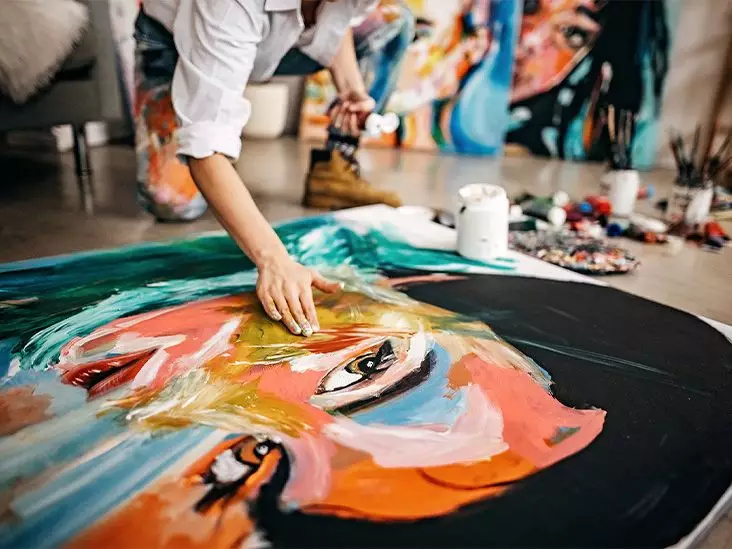Schizophrenia is a profound mental health disorder that disrupts an individual’s perception of reality. It manifests through symptoms such as hallucinations, delusions, and cognitive impairments, deeply affecting one’s thoughts, feelings, and behavior. Often, the distress caused by these symptoms extends beyond the individual, impacting family members and loved ones. This disorder can hinder one’s ability to engage in daily activities, form meaningful relationships, and maintain employment. However, a range of therapeutic interventions and treatments is available to help manage symptoms effectively, one of which is art therapy.
Art therapy presents a dynamic approach that utilizes creative expression to facilitate communication for those grappling with schizophrenia. Traditional verbal communication can be daunting for individuals experiencing this illness, making it challenging to articulate complex emotions and experiences. Art therapy provides a non-verbal outlet through which individuals can convey feelings and visual manifestations of their symptoms. Engaging with various materials—such as paint, clay, or charcoal—not only fosters emotional expression but also allows for exploration of thoughts that are otherwise difficult to articulate. By creating art, individuals can externalize their inner experiences, offering a unique perspective to therapists and caregivers.
The therapeutic benefits of art are notably significant for individuals experiencing hallucinations and other symptoms associated with schizophrenia. By developing a visual representation of their feelings or crisis, individuals can cultivate a clearer understanding of their own experiences. This act of creation promotes emotional relief and clarity, ultimately leading to a sense of personal empowerment. Furthermore, art therapy serves as a bridge, enhancing communication with healthcare providers, family members, and friends by providing a tangible representation of the individual’s subjective reality. This shared visual representation can lead to deeper empathy and understanding, allowing those around them to “see” through their eyes.
While art therapy yields substantial benefits, it is essential to recognize that it does not serve as a standalone treatment. Instead, it is most effective when integrated into a comprehensive treatment regime that includes psychiatric medications and counseling. Antipsychotic medications remain the cornerstone of schizophrenia treatment, aiding in the management of hallucinations and delusions. Complementing these medical interventions with art therapy can enhance self-awareness and provide emotional support. It also encourages individuals to engage with their therapy actively, which may fortify their mental resilience and promote overall well-being.
As with any therapeutic approach, there are considerations to be made. Art therapy is generally regarded as low-risk, but individuals should be mindful that it is not a replacement for prescribed medications. Open communication with a healthcare provider is crucial, particularly if an individual feels empowered by art therapy and contemplates altering their medication regimen. Ensuring safety while incorporating art therapy into their treatment plan allows individuals to maximize benefits while mitigating risks.
History underscores a fascinating relationship between creativity and schizophrenia. Several renowned artists, including Vincent van Gogh and Edvard Munch, navigated the realms of profound mental illness yet created iconic works that resonate with the human experience. These artists have contributed significantly to our understanding of the inner workings of a mind plagued by chaos yet capable of extraordinary creativity. Their legacies testify to the intersection between mental health struggles and artistic expression, serving as inspiration for contemporary art therapists working with clients today.
Involvement from family and community members can amplify the impacts of art therapy. Educational programs geared toward families promote understanding of schizophrenia and provide tools for effective support. Families who recognize the value of art therapy can better engage with their loved ones, enhancing relationships and offering the emotional support necessary for healing. When individuals feel understood, their emotional burdens lighten, facilitating greater openness in expressing their thoughts through art.
Art therapy offers a valuable avenue for individuals with schizophrenia, allowing for the expression of complex emotions and thoughts in a safe and nurturing environment. By fostering creativity, individuals can not only articulate their experiences but also promote emotional relief and self-discovery. While it is not a substitute for traditional treatments, art therapy complements existing approaches, enriching the journey toward healing. Engaging with art can empower individuals, bridging gaps in communication and forging connections with both their inner selves and those around them. As we continue to unravel the potentials of art therapy, it becomes increasingly clear that creativity holds the key to a deeper understanding of the human experience amidst the challenges of mental health disorders.

